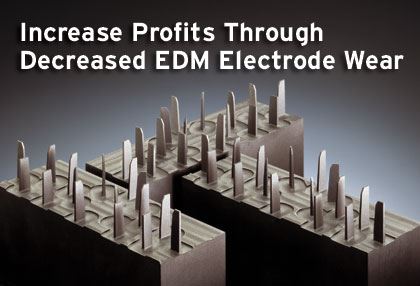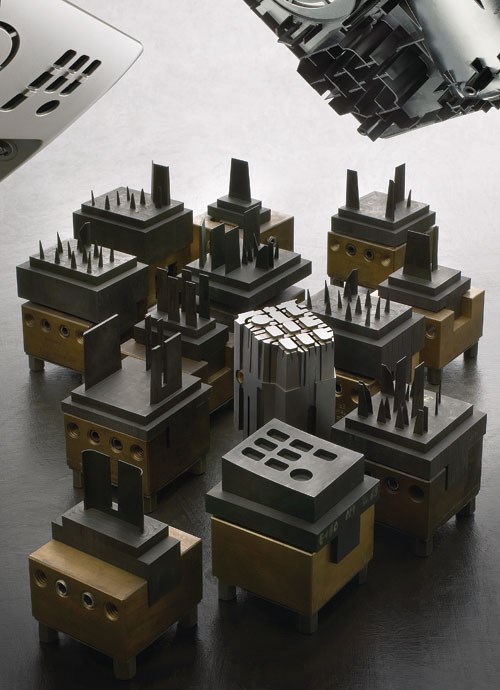Increase Profits Through Decreased EDM Electrode Wear
Recent advancements in the technology behind low-wear capability have drastically improved the machining speeds at which low-electrode-wear application settings can be applied.
Die sinking EDM works wonders in cutting contours or cavities in pre-hardened steel. When dealing with complex shapes, however, milling the electrodes that produce these intricate pieces can be a quite involved and time-consuming process, so manufacturers want to extend electrode life as much as possible.
Extremely low-wear electrode capability is possible, but only a handful of machine tool manufacturers are taking advantage of the process. The technology behind low-wear capability is still somewhat of a mystery in the manufacturing industry, but it can drastically reduce electrode wear. However, the drawback of the technology has always been that it requires users to reduce machining speeds, thus adding to overall part processing times.
Fortunately, recent advancements in the technology have drastically improved the machining speeds at which low-electrode-wear application settings can be applied. These faster speeds further add to the technology’s most significant benefit of allowing shops to burn more cavities with fewer electrodes.
Benefits
Low-electrode-wear technology practically eliminates electrode wear by building a protective layer onto graphite electrodes, maintaining their edges and detail capabilities throughout an entire burn. The technology is especially beneficial for electrodes producing the same cavity shape multiple times.
In instances where it used to take three or four electrodes to produce a complex mold cavity with multiple ribs, today’s low-wear functions can reduce that amount to one, maybe two electrodes. Such a scenario brings forth major cost savings with less money spent on milling additional electrodes, especially ones with highly difficult shapes. The more detailed the electrode, the more the savings.
Additionally, manufacturers can save on graphite materials when producing their electrodes. Because low-wear technology extends the life of courser, more cost-effective graphite, you do not have to rely on the stronger, more expensive finer graphites to increase the life of an electrode.
When it comes to machine set up, fewer electrodes also mean manufacturers can save time by not having to manually switch out electrodes in the middle of a project or rely on someone to program several electrodes into a job.
Although, it’s important to keep in mind that there’s a lot of gray area as to whether or not certain applications will benefit from low-electrode-wear technology. Even though today’s advanced systems allow for cutting faster than previous low-wear technologies, the machining process may still be slowed just a bit.
Considerations
Shops must carefully consider exactly when it would be most beneficial to use low-wear technology. For instance, a simple electrode shape that doesn’t cost a lot to produce might be more advantageous to burn at higher speeds versus switching on low-wear technology to extend electrode life at the cost of slightly slower burn speeds. The decision is most often based on the complexity of cavities and the cost of electrodes used to produce them.
It should also be noted that low-electrode-wear technology really would not benefit applications involving undersizes smaller than 0.008” or those going below a 22 Ra surface finish requirement. And while the technology reduces the wear of an electrode, deterioration will occur in applications involving sharp corners smaller than 0.005” because the technology is unable to maintain such edges on the electrode, thus requiring a second electrode.
Whether a manufacturer applies low-wear technology in their sinker EDM processes or not, today’s systems are extremely easy to use. So simple, in fact, that some systems allow users to easily switch back and forth between low-wear and non-low-wear functionality as often as needed during a single cavity burn.
With a low-electrode-wear system, test runs are always recommended, and if all signs point to showing a benefit, then the savings are practically limitless. If not, it’s a no-harm, no-foul situation because the technology is often a feature that can be simply switched off for returning to normal burn parameters.
Related Content
The Benefits of Hand Scraping
Accuracy and flatness are two benefits of hand scraping that help improve machine loop stiffness, workpiece surface finish and component geometry.
Read MoreSolving Mold Alignment Problems with the Right Alignment Lock
Correct alignment lock selection can reduce maintenance costs and molding downtime, as well as increase part quality over the mold’s entire life.
Read MoreFundamentals of Designing the Optimal Cooling System
The right mold components can help improve mold cooling and thereby produce higher-quality parts.
Read MoreThe Ins and Outs of Hot Runner Temperature Control
A training checklist that explains the why and how of proper hot runner temperature control and system management.
Read MoreRead Next
How to Use Strategic Planning Tools, Data to Manage the Human Side of Business
Q&A with Marion Wells, MMT EAB member and founder of Human Asset Management.
Read MoreReasons to Use Fiber Lasers for Mold Cleaning
Fiber lasers offer a simplicity, speed, control and portability, minimizing mold cleaning risks.
Read MoreAre You a Moldmaker Considering 3D Printing? Consider the 3D Printing Workshop at NPE2024
Presentations will cover 3D printing for mold tooling, material innovation, product development, bridge production and full-scale, high-volume additive manufacturing.
Read More























